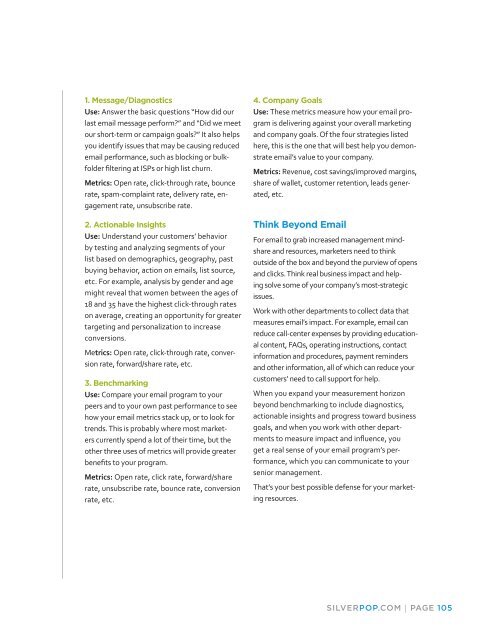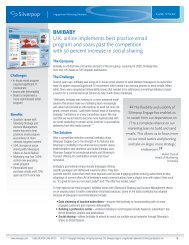eBook - Silverpop
eBook - Silverpop
eBook - Silverpop
You also want an ePaper? Increase the reach of your titles
YUMPU automatically turns print PDFs into web optimized ePapers that Google loves.
1. Message/Diagnostics<br />
Use: Answer the basic questions “How did our<br />
last email message perform?” and “Did we meet<br />
our short-term or campaign goals?” It also helps<br />
you identify issues that may be causing reduced<br />
email performance, such as blocking or bulkfolder<br />
filtering at ISPs or high list churn.<br />
Metrics: Open rate, click-through rate, bounce<br />
rate, spam-complaint rate, delivery rate, engagement<br />
rate, unsubscribe rate.<br />
2. Actionable Insights<br />
Use: Understand your customers’ behavior<br />
by testing and analyzing segments of your<br />
list based on demographics, geography, past<br />
buying behavior, action on emails, list source,<br />
etc. For example, analysis by gender and age<br />
might reveal that women between the ages of<br />
18 and 35 have the highest click-through rates<br />
on average, creating an opportunity for greater<br />
targeting and personalization to increase<br />
conversions.<br />
Metrics: Open rate, click-through rate, conversion<br />
rate, forward/share rate, etc.<br />
3. Benchmarking<br />
Use: Compare your email program to your<br />
peers and to your own past performance to see<br />
how your email metrics stack up, or to look for<br />
trends. This is probably where most marketers<br />
currently spend a lot of their time, but the<br />
other three uses of metrics will provide greater<br />
benefits to your program.<br />
Metrics: Open rate, click rate, forward/share<br />
rate, unsubscribe rate, bounce rate, conversion<br />
rate, etc.<br />
4. Company Goals<br />
Use: These metrics measure how your email program<br />
is delivering against your overall marketing<br />
and company goals. Of the four strategies listed<br />
here, this is the one that will best help you demonstrate<br />
email’s value to your company.<br />
Metrics: Revenue, cost savings/improved margins,<br />
share of wallet, customer retention, leads generated,<br />
etc.<br />
Think Beyond Email<br />
For email to grab increased management mindshare<br />
and resources, marketers need to think<br />
outside of the box and beyond the purview of opens<br />
and clicks. Think real business impact and helping<br />
solve some of your company’s most-strategic<br />
issues.<br />
Work with other departments to collect data that<br />
measures email’s impact. For example, email can<br />
reduce call-center expenses by providing educational<br />
content, FAQs, operating instructions, contact<br />
information and procedures, payment reminders<br />
and other information, all of which can reduce your<br />
customers’ need to call support for help.<br />
When you expand your measurement horizon<br />
beyond benchmarking to include diagnostics,<br />
actionable insights and progress toward business<br />
goals, and when you work with other departments<br />
to measure impact and influence, you<br />
get a real sense of your email program’s performance,<br />
which you can communicate to your<br />
senior management.<br />
That’s your best possible defense for your marketing<br />
resources.<br />
SILVERPOP.COM | PAGE 105







